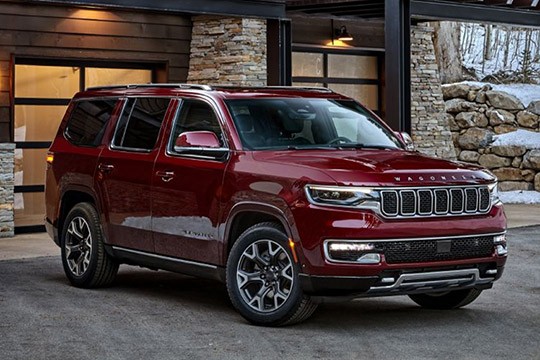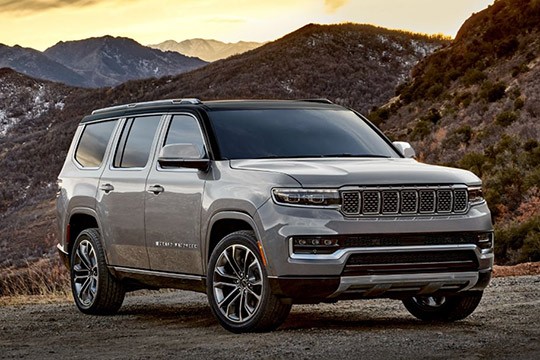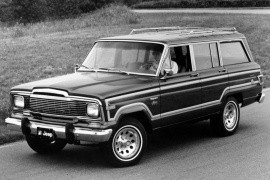JEEP Wagoneer Models/Series Timeline, Specifications & Photos
First production year: 1963
Engines: Mild hybrid, Gasoline
Body style: SUV (Sports Utility Vehicle)
While Jeep built the Grand Wagoneer for up to eight people and impressive comfort and luxury, the Wagoneer was more of a luxurious family SUV or executive car.
Stellantis built the Wagoneer and Grand Wagoneer duo to match, and exceed, the offer from Lincoln Navigator and Cadillac Escalade. It was the most luxurious vehicle ever made by Jeep, and to do that, it started from a blank sheet of paper. The chassis, with its independent air suspension in four corners, and the bodywork were brand new.
Its front fascia was almost like a flat wall with the seven-slats grille above the fat bumper. Its LED headlights incorporated the turn-signals at the top while the daytime running lights and the fog-lights found their way at the bottom of the bumper, above the fixed, exposed, tow-hooks. From its sides, the Wagoneer showed slightly curved, almost vertical panels. The carmaker installed slim LED strips for the taillights and a wide, tall tailgate.
Like its bigger brother, the Wagoneer showed three trim levels, named simply 1, 2, or 3. For the driver, Jeep installed a TFT display in the instrument cluster and, depending on the trim level, one or more touch-screens on the center stack. Between the front leather-wrapped seats, there was a wide center console, which could incorporate a safe deposit box. The middle row was available with either a bench for three or captain seats with or without a center armrest. Even the third row, which was fit for three, could host three full-grown adults.
Jeep installed a 5.7-liter Hemi V-8 engine paired with an eight-speed automatic transmission and a high and low gear transfer case. The adaptive air suspension could increase the ground clearance according to one of the four settings selected by the driver. Last but not least, it could tow up to 10,000 lbs (4,535 kg).
Jeep dust-off the Wagoneer and Grand Wagoneer nameplates and re-introduced them on the market in 2021, three decades after the last original Wagoneer rolled-out from the assembly lines.
But Jeep did that to match the Cadillac Escalade, and Lincoln Navigator offers on the market. Maybe someone from the Stellantis (the new corporate name) considered that it could make a real competitor for the big, luxurious SUVs offered by the competition. And it did it. The Wagoneer and Grand Wagoneer were top dogs in the luxury market.
Jeep built the Grand Wagoneer on top of an entirely new platform. It was a body-on-frame construction, and the bodywork looked intimidating with its chromed, seven-slats grille at the front. As expected for a premium SUV, it featured standard LED headlights, fog-lights, and any other lights on the vehicle.
Inside, the Grand Wagoneer showed an impression of luxury and comfort. It showed up to seven big screens on the instrument cluster, two on the center stack, one in front of the side passenger, and another three for the middle row. Jeep made the wood-trims from American satin walnut, and it sculpted the “Grand Wagoneer” name in it. Unusually, the steering wheel sported a small piece of wood under the airbag container. The wide, leather-wrapped front seats featured massage, heating, and ventilation. Its second-row was available with either a bench for three or two captain seats, which could rotate 180 degrees. In the last row, the Grand Wagoneer offered another three seats on the leather bench.
Stellantis developed a new platform for the Grand Wagoneer, including an air suspension in all corners with four adjustment levels. Even though most of them never saw real offroad situations, the carmaker installed various transmission settings, from sport to snow, sand/mud, and rocks.
The Wagoneer was built for three decades and it was the biggest, heaviest, most powerful, and most expensive 4x4 vehicle in the world at the time of its launch in 1963. And it kept its attributes for a long time.
It was considered one of the earliest SUVs made by Jeep, but it was more of a truck than an SUV since it was built on a Jeep Gladiator pickup-truck chassis. But the luxurious interior and the powerful engines would place it in the SUV-territory.
To gain a better appeal in the public's eyes, the Wagoneer was styled more like a station wagon than a 4x4. Its lower front fenders than the hood, the raked (for those times) A-pillars, and the big side windows were specific for a station-wagon. The early models featured a narrow and tall grille and flush to the front fascia four rounded headlights. Over time, these were changed to rectangular shaped ones.
Inside, the top trim levels, named Limited, featured leather bucket-seats in the front and a bench for three. It could have been folded or completely removed to increase the trunk room up to 2700 liters (95 cu-ft). The tailgate was split-opened, with the window going up and the lower part going down. The dashboard featured rounded dials and plastic-wood.
The Wagoneer was fitted with 6- or 8-cylinder engines. For the transmission, it featured 3 or 4-speed manual transmissions or a 3-speed automatic. The 4x4 system was engaged from a dash-mounted switch, while the low-range gear could have been engaged via a floor-mounted lever.


